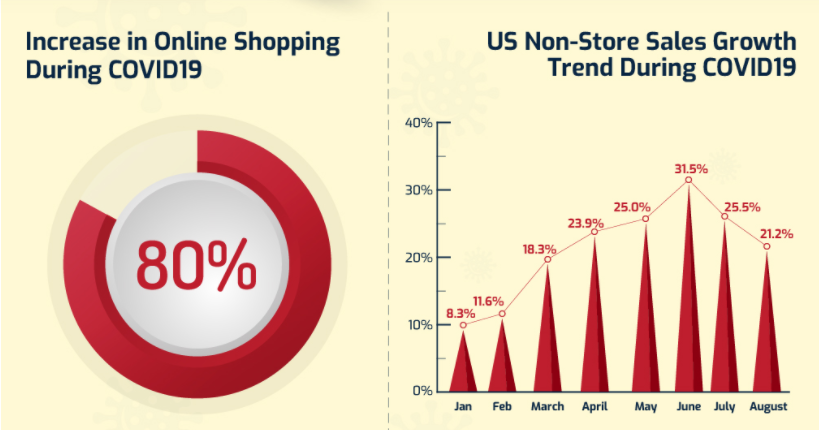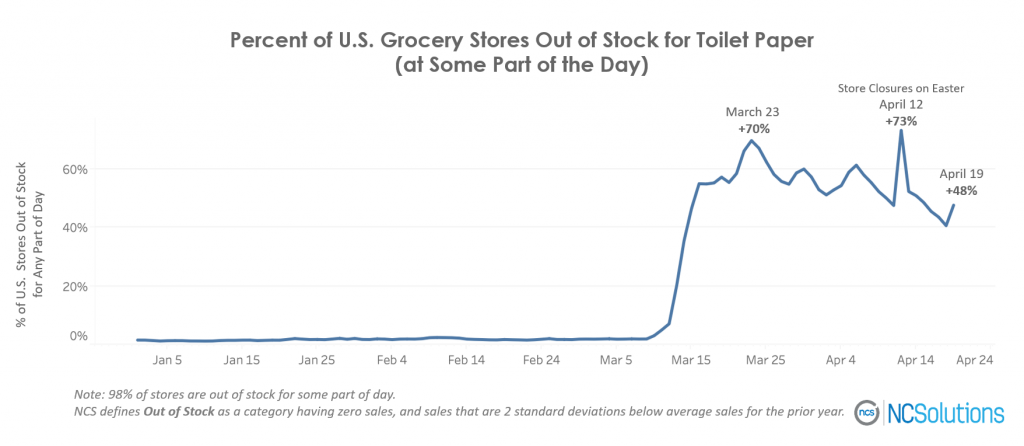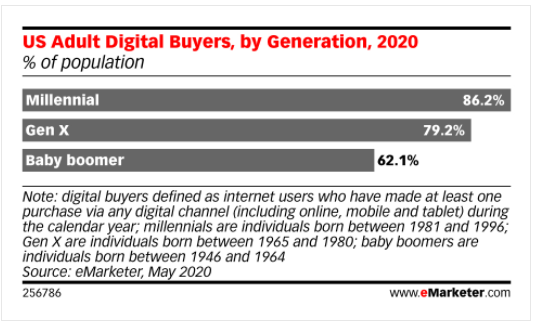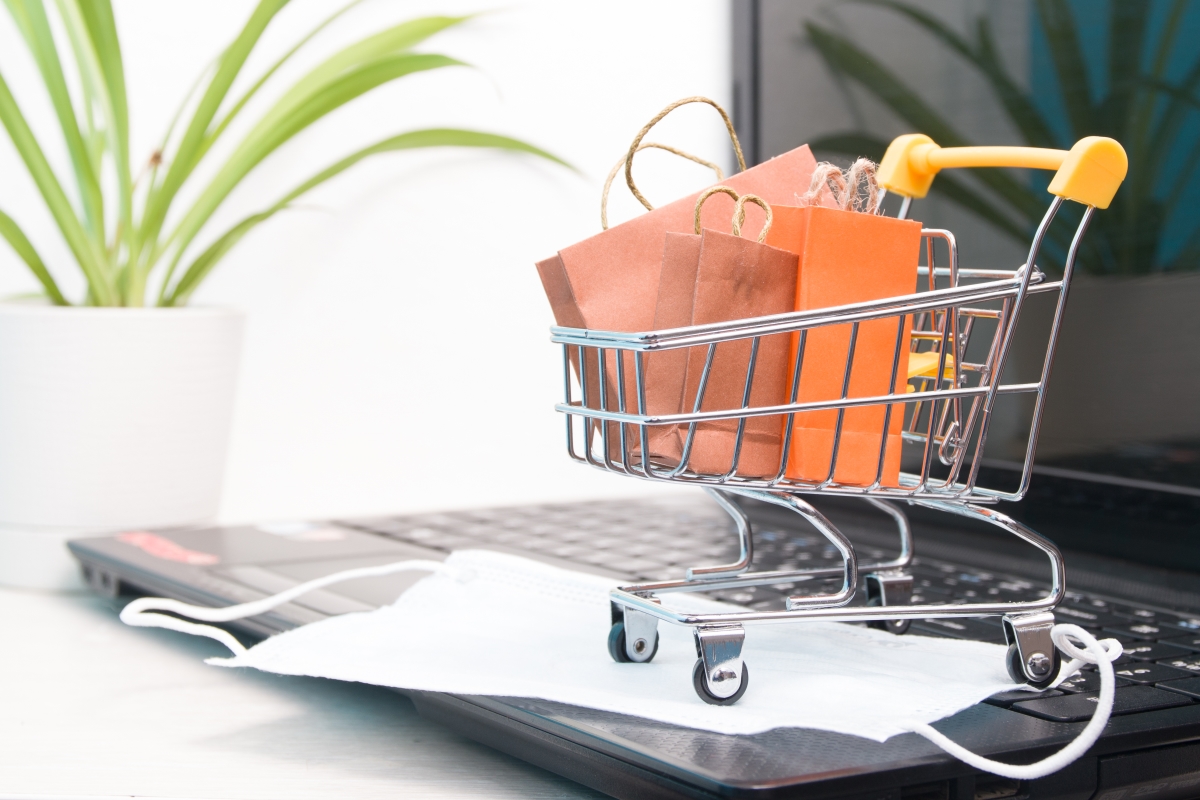Saturated e-commerce markets like the US and Germany witnessed a 52% and 30% rise in online shopping. Emerging markets recorded up to an 80% increase in online shopping during COVID-19. Hygiene products and packaged food were among the highest selling commodities, but with remote working growing popular, sales of home entertainment and home improvement products also gained pace.
Almost two years since the first case of COVID was recorded, the e-commerce shape has transformed. From offering millennials access to quality products to becoming boomers’ favorite shopping destination, the e-commerce industry has covered a long way in very little time.
While all existing e-commerce players had a great time collaborating with local governments, delivering essentials, and building pandemic proof systems, some of them suffered. Players with a lack of vision or customer-centric practices had a tough time accommodating. However, the COVID pandemic tested the preparedness of all e-commerce companies and rewarded many with multi-fold growth.

Table of Contents
Customer’s Reaction to COVID-19
End-users had a bizarre reaction to the COVID outbreak. Disposal gloves recorded a 670% increase in sales, weight training products sales increased by almost 300%, and immunity booster supplements and medicines recorded a sale spike of around 400%.
We can sum customer’s reaction to the COVID-19 in the following segments:
Panic Buying
The virus was first recorded in Wuhan, China. The local government imposed a lockdown and controlled the spread. This becomes a status quo, and governments from around the world started following it. With Lockdown becoming the modus operandi for curbing the COVID outbreak, people panicked.
The uncertainty led to panic buying. In the United States, people started hoarding toilet paper and packaged food products. Similarly, in India masks, hand sanitizers were out of stock within the first few days of the outbreak. Germany reported a scarcity of health monitors and oximeters.

Here’s a report that showcases stores getting out of stock. Toilet paper was perhaps the most hoarded product at the beginning of the outbreak in the United States.
Order Cancellation
With the COVID-19 outbreak, organizations started moving employees to remote working, and it posed a great threat to the employment of millions in India. With India offering back-office support to numerous countries, working from home meant compromising on data security. Posed with a threat of job loss, employees developed a frugal mindset and started curbing their expenses. As a result, many online orders were canceled initially.
With complete Lockdown imposed in multiple countries, even e-commerce players were not allowed to function. However, with time and dialogue, governments enabled e-commerce stores to deliver essentials under the pandemic act. Still, during the initial days of Lockdown, millions of orders were canceled, and thousands were lost in transit too.
Boomer’s Migration to E-commerce
A reputed report suggests that 62% of boomers have migrated to e-commerce stores due to COVID. The outbreak restricted this generation to their homes. However, high-speed internet allowed them to experiment, and fast delivery, quality support, and varied payment options enamored them, and now they are loyal users.
Boomers started their e-commerce journey with essentials, but studies show that they now prefer online shopping for almost every purchase. Impressed by ease of accessibility, omnichannel experience, and incomparable service, Boomers have decided to continue shopping online even after the pandemic ends.

A Frugal Mindset
As mentioned earlier, the threat of job loss coaxed users in India to cancel their extravagant purchase orders and adopt a frugal mindset. With time, the frugal mindset has evolved, and customers are now looking forward to buying the same product at an affordable price. Moreover, e-commerce players have expanded to several new domains to offer existing customers a quality shopping experience during the pandemic; they are left with minimal funds to facilitate sales.
Customers understand the dilemma and are willing to accommodate. The sudden increase in demand for frugal products showcases how customers are adopting a new route to acquire quality products without paying a lot.
E-commerce Opportunities due to COVID-19
1. Build a Refurbished Products Store
96% of all people who bought refurbished products were looking for quality products at affordable prices. Refurbished products are growing popular because people want to “buy products of a popular brand at an affordable price.” 89% of people who participated in a survey were happy with the experience of using a refurbished product.
Significant statistics related to refurbished products:
- The refurbished market for consumer electronics is estimated to be worth $10 Billion
- 94% of buyers see refurbished products as a viable option
- 81% of buyers who participated in the survey are likely to recommend the refurbished product
- 57% of end-users believe brand-name to be a key differentiator in refurbished purchases
- 68% of users think warranty to be critical information when buying a refurbished product
How to Build a Successful Refurbished Store?
Refurbished products were discarded after a few usages but are good enough to be resold after a refresh. Engineers work on strengthening the products by updating software packages and replacing damaged parts. The electronic industry is fast-paced, and constant innovation is regularly coaxing people to charge phones and other devices. Often phones and other devices are discarded just because a better version was made available. All such products with a bit of upgrade can be sold to people with smaller budgets.
Steps to Build a Successful Refurbished Store
Be Data-Driven
A study shows 57% of people will buy refurbished products only from popular brands. Since people are unwilling to pay for local or not-so-popular products, it will be futile to invest in refurbishing less popular products.
A data-driven approach will allow businesses to discover popular products and then acquire them in bulk and refurbish them.
Procure Exchanged Products
All popular electronic brands facilitate exchange offer on Amazon and Flipkart. Often these products are sent back to the manufacturer, where they use the good working parts. However, there are instances where exchanged products are sold in bulk to third parties. Refurbished stores can acquire products in dimension from such sales. Third parties like Cashify can help these store owners with more direct procurement.
Target Tier 2 Cities
Exchange offers are popular among affluent masses and lead a comfortable life. Tier 2 cities people struggle to meet their growing demands; hence selling them branded products at a discounted price makes sense. With refurbished products as good as originals available at a reasonable price, tier-2 city people will be able to achieve their desires and fulfill their needs too.
Optimize Buying Experience
People don’t have to go through a second-hand experience because they buy a second-hand product. Here’s how to optimize the background for a refurbished product:
- Focus on repackaging it as a new product
- Offer warranty even for the refurbished products
- Offer credit and debit card offers on these products
- Prioritize compliance
- Ensure similar logistic experience for refurbished products too
2. Take Traditional Retail Businesses Online
With COVID-related restrictions, people had a tough time visiting the market and procuring products for daily use. E-commerce stores stepped in by delivering essentials. With ease in Lockdown, online stores started delivering other products too.
In many countries, local markets are still not allowed to function fully, affecting the lives of ordinary people. Prevalent practices, local culture, and people’s beliefs have taken a hit because of the unavailability of local products. With small businesses shutting down and the non-availability of products on the web, people are coaxed to forget their culture and roots.
Flipkart’s 2GUD is a brand new platform that aids common people by offering them traditional products. Popular local brands, traditional retailers are now able to sell online and reach both locals and people who moved out.
Building a traditional retail business is perhaps the most significant e-commerce opportunity due to COVID-19. Here are some of the benefits:
- People can access both local products and the ease of e-commerce
- Enables users to plan their purchase without moving an inch
- Help local sellers reach a global audience
How to Start Building an Online Store for Traditional Retailers?
Take “local brands” & “retail chains” online
In countries like India and China, pickles are very popular. While in India, veg pickles are popular, Chinese prefer non-vegetarian pickles. Finding spots of numerous varieties online is a challenging task, and it has innumerable business opportunities. By taking similar local retails and their chains online, e-commerce platforms can achieve greatness.
Similarly, Americans love their sauce, and they often travel hours to procure raw material or the final product from a particular store. Thus, helping these brands go online can help both parties, the end-users as well as webmasters.
Expand digital footprint of local products globally
In the global era, where people travel from one country to another to search for better opportunities, e-commerce stores can help these local retailers find a global audience. Just like Pizza traveled from western to Asian countries, pickles can also grow very popular in the States.
It focuses on analytics to identify products sought but aren’t available, and then supporting local retailers can prove to be a game-changer.
3. A B2B E-commerce Opportunity with Local Herbs
During COVID, we witness how India exported drugs to the US, and it returned the favor by sending raw vaccine material during the second wave. With diseases going global, natural materials also need to be sold on the worldwide stage.
Starting a B2B platform that deals in local herbs, medicines and cures have huge potential. For example, immunity boosters are very much in demand; China and India have a heavy stock of masalas and local spices.
4. A Platform to Sell Remote Working Products
Bloomberg reports Google saved $1 billion by letting employees work remotely. Well, remote working is helping cash-starved startups survive. Massive saving on rent, free coffee, and transport allowance is allowing organizations to self-fund themselves.
Companies can acquire seed funds for their expansion plans just by letting employees work remotely.
Work from home has opened new doors of opportunity for e-commerce aspirants. Catering home improvement products is perhaps the most significant e-commerce opportunity due to COVID-19. Building a business around work from home because:
- 33% of companies have promised to continue with remote working post COVID
- E-commerce platforms registered a record sale in chairs and portable tables since remote working started
- Organizations are sharing incentives to make remote working comfortable
- Ergonomic products in demand to remote working Economic Times
5. E-commerce Platform That Withstands Pandemics
Millions of orders were canceled when COVID-19 induced Lockdown came into force. With a panic among the users, the only ideal solution was to cancel the order. Later, it was identified that thousands of products were lost in transit. Failure of logistics system had caused sellers a heavy loss while e-commerce stores had trouble answering their customers.
The key to building a platform that withstands pandemics lies in:
Location-Based Selling to Minimize Disruption
Building a robust system is perhaps the most significant e-commerce opportunity due to COVID-19. Why location-based selling? Answering this question will help e-commerce leaders understand why sellers’ location matters.
- It reduces the delivery time.
- It helps control the logistic expenditure.
- Minimizes instances of “lost in transit.”
- It helps customers plan their purchases better.
- Helps seller plan in advance and place inventory at multiple locations
Hybrid model to stop the system from collapsing
While e-commerce adoption has increased ever since the COVID outbreak, but initially, the plan was wrecked. The sudden announcement of Lockdown and restrictions on freight movement put a stop at e-commerce processes. Users relied on their local retail stores to cover their day-to-day needs.
With a hybrid model, players can offer end-users access to put irrespective of restrictions. Users will have the liberty to either get it delivered or pick it up from a local partner. This model has multiple benefits like:
- It settles the battle between retail and online stores
- It builds a network that will never fail
- It makes e-commerce a trusted entity among end-users
- Supports both users as well as local sellers
Outsource
Perhaps the biggest lesson from COVID is to outsource. All organizations that had trusted outsourcing partners saved their businesses from disruption. Their processes continued and also the leaders mitigated the risk at the partner organization. Outsourcing can do a lot of things, including:
- Continue with process improvements like catalog management and product management
- Continue to engage buyers and sellers even when the main office is not working efficiently
- Rent additional expertise to build robust processes to see through sudden challenges.
6. Herbal & Beauty Products
A Times of India article titled “Going back to our Roots” showcases how the COVID pandemic has helped people differentiate among needs and wants. The earlier days of COVID Lockdown had the entire world experienced a pollution-free planet. It allowed people to ponder over ideas that could help them lead healthier lives.
With most services, including salons, parlors, and gyms closed, people started looking for home workouts and home grooming ideas. Alone, the men’s grooming industry is worth $11 billion. During Lockdown, people focused on procuring products online and grooming at home, which has faired well. Now people understand that it is the product and not the salon that helped them shine.
With more emphasis on products, healthy and natural items, it makes sense to start a herbal and beauty e-commerce platform.
Herbal Products for Immunity
Immunity is now a key attribute. We have seen how adding an “immunity booster” improved the likability of a product during the COVID lockdown. However, people are unwilling to take the risk; hence a platform that sells immunity-related herbal products is likely to win the battle.
Beauty Industry in Loss
The loss of the beauty industry due to COVID is estimated to be $3 billion. Let us tell you, the amount of products being sold has increased, the loss comes from parlor and salon fees. Also, beauty companies have registered growth in revenue because their sale hasn’t dropped, but the commission they paid to salons has come down.
End-users are now acquiring products directly from the online and offline channels and trying them independently and not relying on parlor or salons.
Self-Satisfaction on Rising
We have already witnessed the rise of self-help in customer service, and now 56% of people have reported being satisfied with home beauty practices. The decreasing reliance on parlor is likely to benefit both the end-users and manufacturers. The final price will drop with no middle man involved, and the overall profit will also increase.
32% of participants agreed that they don’t need to visit parlors anymore, yet another testimony for an herbal product store will become popular. It is perhaps one of the unique e-commerce opportunities due to COVID-19.

Final Thoughts on E-commerce Opportunities During COVID-19
The E-commerce landscape is evolving; new technologies like AR, ML, and AI enable new players with customer acquisition. However, the traditional players tackle emerging challenges by relying on proven practices like catalog management, product management, and e-commerce analytics.
COVID-19 has presented e-commerce stores with newer opportunities, and with an effective plan, online stores can compound their annual growth and profit. Outsourcing plays a crucial role in e-commerce success; outsourcing takes away the risk, offers innovation, and serves as a center of excellence. With the affordable solution and industrial expertise available on rent, e-commerce players can gain heavily with outsourcing.

